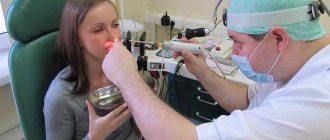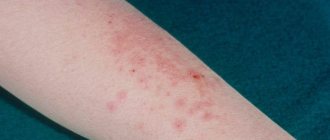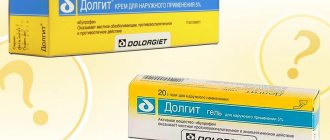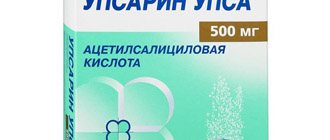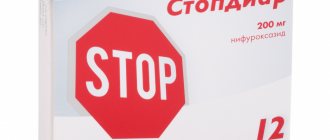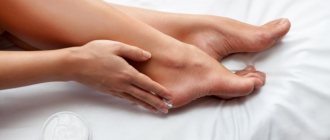Dexpanthenol is a substance derived from the water-soluble B vitamin - pantothenic acid. It is this that the body’s need increases when the skin and tissues are damaged. To compensate for the lack of substance and accelerate cell regeneration, use the topical drug D-Panthenol.
Types of dosage forms, composition
D-Panthenol is available in the form of ointment and cream. 1 g of both forms contains 50 mg of dexpanthenol.
D-Panthenol cream has a white color, a uniform structure, and no pungent odor. It is packaged in tubes of 25 or 50 g, which are sold in boxes with instructions. Additional ingredients include propylene glycol, methyl parahydroxy- and propyl parahydroxybenzoate, macrogol cetostearate, cetostearyl alcohol, paraffin, petroleum jelly, sodium hydrogen phosphate dodecahydrate, potassium dihydrogen phosphate, purified water.
D-Panthenol ointment has a white color with a yellowish tint, a thicker structure and a faint odor. It is packaged in 30 g aluminum tubes, which are placed in a box complete with instructions. In addition to dexpanthenol, it contains glycerin, lanolin, petroleum jelly, liquid and solid paraffin, stearyl and cetyl alcohols, and water.
pharmachologic effect
Manufacturer: ZAO Zelenaya Dubrava, Russia;
LIBREDERM, Russia; Dr. Gerhard Mann, Germany Release form: ointment, cream, aerosol
Active ingredient: dexpanthenol
Synonyms: D-panthenol, Bepanten, Dexpanthenol, Pantoderm
The main active ingredient is dexpanthenol. When absorbed, it enters the skin cells, where it is converted into pantothenic acid (vitamin B5). Pantothenic acid becomes part of coenzyme A, which is involved in the oxidation of proteins, fats and carbohydrates, and in the synthesis of fatty acids. Stimulates self-healing of skin cells. Plays an important role in healing, regeneration, cellular metabolism.
Indications for use of D-Panthenol
Everyone needs to know what D-panthenol ointment is used for. The main reasons for use are a variety of mild skin damage resulting from temperature, mechanical or chemical exposure. Indications include:
- skin burns, including those resulting from sunburn;
- wounds in the form of abrasions and scratches;
- dermatitis;
- uncomplicated diaper dermatitis in infants and its prevention;
- treatment and prevention of nipple injury during breastfeeding;
- dryness and tightness of the skin
Depanthenol cream is used to protect the epidermis from the effects of frost and wind, for the prevention and treatment of diaper rash, when treating the skin around the openings for the removal of colostomy, tracheostoma or gastrostomy.
The ointment is used in the treatment of bedsores, trophic ulcers, anal fissures, and non-infected wounds after surgical interventions.
Panthenol - instructions for use
For external use. Apply a thin layer to the damaged area of the skin 1-2 times a day. On the nipples of a nursing mother - after each feeding, before the next feeding, the product must be washed off with warm water without detergent. When caring for an infant and treating diaper dermatitis - after each diaper change.
Panthenol cream, ointment or spray, which is better?
For ease of use, it is available in several dosage forms:
- Spray. White foam with a sour odor. The product of choice for burns, as it is instantly absorbed and does not leave a greasy barrier layer on the surface.
Oily and greasy textures interfere with the release of heat and aggravate thermal damage, so for a burn, do not use ointment, but Panthenol aerosol. It works in the superficial layers of the skin and is useful for mild diaper rash in babies.
- Cream. Non-greasy texture. Absorbs without leaving stains. Suitable for daily routine care.
- Ointment. It has a greasy base and penetrates deeply into the skin. Suitable in cases where it is necessary to create a protective barrier between the aggressive external environment and the wound: for the treatment of cracked nipples, dermatitis in adults and children, severe diaper rash in newborns.
The difference between dosage forms is in the depth of penetration of the active components and the rate of absorption. There are analogues for each dosage form.
Effects of the drug
The main effect of the drug is to help in tissue regeneration. The medication also has the following positive effects:
- relieves inflammation at the site of violation of the integrity of the skin;
- reduces irritation, including after cosmetic procedures;
- restores and moisturizes the skin, fights peeling;
- helps wounds heal faster;
- promotes faster renewal of the skin in case of burns;
- relieves chafing and redness.
Panthenol or D-Panthenol, which is better?
Manufacturer: JADRAN-GALENSKI LABORATORIES, Croatia
Release form: cream, ointment, aerosol
Active ingredient: dexpanthenol
Synonyms: Bepanten, Panthenol, Dexpanthenol, Pantoderm
It has a composition similar to Bepanten and Panthenol. Contains 5% dexpanthenol. The drug is of European quality at a price slightly lower than the price of Bepanten.
The drug is indicated in the same cases as Bepanten. The Depanthenol brand is less advertised, but has the properties of a European product. Cheap analogues of Panthenol for children - D-panthenol ointment and cream. The drug of choice if you need a remedy for the whole family.
Panthenol can be produced as a medicine; you need to check with the pharmacy what exactly is indicated on the package. Bought in a supermarket in the cosmetics department, it is a dietary supplement, not a medicine.
How to use, what is best to use
Instructions for use of D-Panthenol ointment and cream contain recommendations to use the product 2-4 times a day or more often. Apply the required amount of the substance with light rubbing movements to the affected area of dry skin.
If the application site is infected, then pre-treatment with an antiseptic - Miramistin or Chlorhexidine - is required; it is not advisable to use hydrogen peroxide.
Ointment and cream differ in their texture: the ointment is based on fatty components that create a protective film on the surface that softens and nourishes the skin. Therefore, it is better to use the ointment to prevent diaper rash, frostbite, and dermatitis in infants.
The cream is more liquid because it contains water. It is absorbed easier and faster, therefore it is indicated for mild frostbite, thermal burns, and for protection from harmful weather factors.
Which is better Panthenol or Bepanten
, Germany
Release form: ointment, cream, lotion, hygienic lipstick
Active ingredient: dexpanthenol
Synonyms: D-panthenol, Panthenol, Dexpanthenol, Pantoderm
A popular analogue of Panthenol is Bepanten ointment and cream. Has similar indications for use. Widely used in pediatrics against diaper rash and dermatitis.
There is Bepanten Plus cream - this is an analogue with the addition of the antimicrobial chlorhexidine. Apply to bedsores, infected and post-operative wounds. Relieves pain due to the cooling effect. Panthenol cream and its analogues do not have a bactericidal effect.
Panthenol is produced by many companies and most often analogues are registered as a cosmetic product. This reduces formulation requirements and makes it easier for the manufacturer to bring the product to market.
Bepanten is an analogue of choice when:
- you need to treat diaper rash or care for your baby’s skin;
- cracks in the nipples of a nursing mother.
Bepanten is registered as a medicine, which makes its use safe for newborns and nursing mothers.
Panthenol is better suited for moisturizing the face and hands, against burns and abrasions.
Use in children and pregnant women
Pregnancy and breastfeeding are not an obstacle to using D-Panthenol for external use. The substances of the drug do not penetrate the placenta and do not have a negative effect on the process of formation and development of the fetus.
The cream or ointment is recommended for use by women when caring for the mammary glands: it is necessary to lubricate the nipples after each application to the breast to prevent microcracks and injuries.
For children, the product can be used from birth; the cream or ointment is applied to the skin under the diaper at each diaper change or after hygiene procedures. For older children, D-Panthenol will help quickly heal minor cuts, abrasions, and scratches.
Analogues of Panthenol
An analogue of Panthenol is an ointment, aerosol or cream with a similar composition, with a different active substance, sometimes with additional components. Each manufacturer tries to create the most useful and safe product. Add hyaluronic acid, oils, allantoin, string, aloe vera. Replacing Panthenol, if necessary, can be profitable and convenient.
| A drug | Active substance | Age | Average price, in rubles | Manufacturer country |
| Panthenol | Dexpanthenol | Depends on the manufacturer | 140-600 | Russia, etc. |
| Bepanten | From birth | 450-800 | Germany | |
| Dexpanthenol | 70-90 | Russia | ||
| De Panthenol | 480-530 | Croatia | ||
| Olazol | Sea buckthorn oil, chloramphenicol, anesthesin, boric acid | From birth | 90-120 | Russia |
| Methyluracil | Dioxomethyltetrahydropyrimidine | From 8 years old | 80-110 | |
| Levomekol | Dioxomethyltetrahydropyrimidine, chloramphenicol | From 1 year | 90-150 | |
| Solcoseryl | Solcoseryl | From birth | 600-800 | Switzerland |
| Rescuer | Olive oil, calendula oil extract, turpentine oil, sea buckthorn oil | Children's – from birth | 150-160 | Russia |
| Dexpan Plus | Dexpanthenol, allantoin, shea butter | From birth | 250-300 | India |
Panthenol analogs are available in pharmacies without a prescription.
Dexpan Plus
Manufacturer: Dr. Reddis Laboratories, India
Release form: cream
Active ingredients: dexpanthenol, allantoin, shea butter
Refers to cosmetics. Contains an effective concentration of dexpanthenol and allantoin - a skin moisturizing substance. Allantoin helps eliminate dead skin cells, restore the natural lipid barrier, and soothes irritations. Little shea softens dehydrated skin.
Dexpan Plus cream is good for daily care and when traveling, when there is a chance of getting sunburned and drying out exposed areas of the body.
Levomekol
Manufacturer: Nizhpharm JSC, Russia
Release form: ointment
Active ingredient: chloramphenicol, dioxomethyltetrahydropyrimidine
Medicinal antimicrobial analogue.
It is used to prevent infection of wounds and in the postoperative period.
Not used for infants.
Levomekol for burns is effective when infection has occurred. It has antibacterial and wound-healing properties.
The Levomekol analogue is cheaper than Panthenol cream and ointment; its price in Russia is 90-150 rubles.
Rescuer
Manufacturer: Lumi LLC
Release form: balm
Active ingredient: olive oil, calendula oil extract, turpentine oil, sea buckthorn oil
Release form:
- Balm Rescuer;
- Rescuer Forte;
- Children's lifeguard.
It works due to natural biologically active components and vitamin complexes of sea buckthorn, olive and turpentine oil. It has a mild antimicrobial, regenerating effect similar to synthetic agents.
Solcoseryl
Manufacturer: MEDA Pharma LLC, Switzerland
Release form: gel, ointment
Active ingredient: solcoseryl (deproteinized hydrolysate from calf blood)
Improves oxygen supply to cells and collagen synthesis. Accelerates tissue regeneration. Solcoseryl gel has a light texture, has no fat in the base, and is absorbed immediately.
Used for weeping wounds, bedsores, trophic ulcers.
The ointment is applied to dry, difficult-to-heal wounds.
Methyluracil
Manufacturer: Nizhpharm JSC, Russia
Release form: ointment
Active ingredient: dioxomethyltetrahydropyrimidine
It has a fundamentally different composition and can conditionally be considered an analogue, since Methyluracil is actively used to treat poorly healing wounds and bedsores in patients with circulatory disorders.
It has the properties of a tissue repair stimulator and stimulates healing at the cellular level.
Used as a budget substitute for Panthenol, not suitable for children.
Panthenol or Olazol – which is better?
Manufacturer: ALTAIVITAMINS (Russia)
Release form: aerosol for external use
Active ingredient: benzocaine
Analogue Olazol spray contains an anesthetic component, suitable for:
- for treating fresh abrasions and wounds that hurt;
- for the treatment of infected lesions;
- for burns of II–III degree – analogue of choice;
- for itchy dermatitis;
- against non-healing bedsores.
Panthenol ointment and its analogues with Dexpanthenol are used when there is no need to relieve pain and treat (prevent) infection. Apply to clean wounds, diaper rash, intact skin.
As an analogue of Panthenol for burns, Olazol foam is more suitable, it relieves pain.
